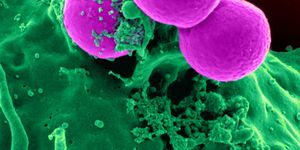Improving microbial elecrosynthesis
New research from a KAUST team highlights the development of a semiconductive photocatalyst that recycles CO2 and converts CO2 emissions into commercially-important chemicals through a process called microbial elecrosynthesis. The findings are published in the journal Applied Energy.
Lead researcher Bin Bian explains that there are many technologies that aim to control the bioelectrochemical process that recycles CO2. "Microbial electrosynthesis (MES), coupled with a renewable energy supply, could be one such technology," Bian says.
MES works by taking advantage of some microbes’ ability to take up CO2 and convert it into chemicals like acetate. For example, chemolithoautotroph microbes in nature metabolize minerals as an energy source through the process of shuttling electrons. In MES, microbes are provided with a constant supply of electrons and protons from anodic water splitting in an electrochemical cell in order to continually trigger this metabolization process. The team’s most recent study aimed to decrease the amount of energy required to make this process possible.
"In MES systems, the process that consumes the most energy is believed to be the oxygen evolution reaction (OER)," Bian explains. In order to reduce the energy needed, past studies have attempted using light-capturing anode materials like titanium dioxide to capture energy from the sun to help drive the OER. Bian’s team spun this idea and instead tried implementing the light-harvesting material bismuth vanadate in the photoanode.
Using their bismuth vanadate photocatalyst, the researchers were able to show how absorbing solar energy could help reduce the energy required for MES. "We obtained solar-to-acetate conversion efficiency of 1.65%, which is the highest reported so far," Pascal Saikaly says. "This efficiency is around eight times higher than the 0.2% efficiency of global natural photosynthesis, which is nature's solar-powered process for converting CO2 into energy-rich molecules," Bian adds.
The team was able to demonstrate how bismuth vanadate makes the MES cell system more efficient because it absorbs energy from a much broader range of the solar spectrum than titanium dioxide. "The next step for us is to test our system under real sunlight and monitor the resilience of the biocatalysts under an intermittent renewable energy source," Saikaly says.
Sources: Applied Energy, Eureka Alert








